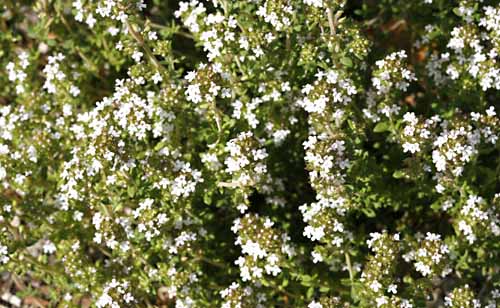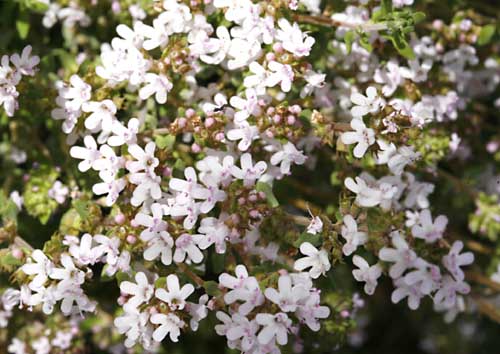This is a wonderful ground cover plant for those hot dry areas where little else is growing. It needs full sun to thrive and must have a well drained soil. It thrives on poor soils and does poorly on rich ones. It needs little water and is very drought tolerant. In late spring it produces a multitude of pink flowers the cover the whole plant turning the whole area into a carpet of pink. It needs very little care once established, but does benefit from a yearly pruning to keep the plants fresh and strong. Deer and rabbits don't eat it, and it's also a really great kitchen herb, what more could you want from a plant.
Description of Thyme (Thymus vulgaris).
A hardy woody low growing perennial plant reaching from 6-12 inches (15-30cm) in height. Hardy to zone 5. It is evergreen with tiny leaves from 1/8 inch to 1/2 inches (0.3-1.2 cm) in length. They are narrow and elliptical, greenish-gray in color. Their miniature stalks attach them to the square stems in pairs. In late spring it produces flowers at the tops of the stems in whorls of pink to lilac flowers. The most prolific flowering is in spring but the plant may continue to flower through until August depending on the temperature. The whole plant is aromatic, it grows in bushy many branched spreading mounds that increase in size as the plant matures. New upright stems are produced yearly and are soft and flexible but turn woody as the year progresses increasing the plants size.
Growing Thyme (Thymus vulgaris) from seed.
Thyme seeds are quite small and the seedlings take quite a while to develop into reasonable sized plants. For this reason we do not recommend sowing in place as it takes a lot of weeding to keep the bed clear until the plants are large enough. Sowing indoors is recommended.
Germination can be erratic so be patient with your seed trays as they wont all germinate at the same time. We have had some seeds take 8 weeks to appear while the first ones were up in a few days.
Follow our
general growing instructions for tiny seeds and barely covering the seed, planting too deep will cause the seeds not to germinate. Sow in late winter early spring at least six weeks before the last frost date (early March is ideal). Germination usually takes between 8-20 days but can be any range as already stated. Transplant each seedling as it becomes large enough taking care not to disturb the other seeds if possible. We prefer to seed into plug trays this way each plant can be cared for without disturbing the other seedlings.
Grow plants on to at least three inches in height before setting outside. Plant out with a spacing of between 14- 20 inches (36-50 cm). Thyme will spread outwards and fill the gaps.
Location and care of Thyme (Thymus vulgaris).
Thyme likes a full sun location on well drained soil that are not too acid, slightly alkaline is idea. pH range 6.5 and 8.5. Sandy or slightly rocky soil is ideal but it wont tolerate heavy clay soils or others that don't drain well. Once established Thyme needs very little additional water and once established takes very little care. It prefers a poorish soil and will produce better tasting leaves with little compost or fertilizer. It is an ideal plant for hot dry areas where little else is growing as long as the soil is poor it does not do well on rich soils.
However after the third year it could benefit from a slight addition of nutrients, a liquid feed once a year (when no rain is forecast) or a thin spreading of compost over the bed. Use a finely ground mixture so it can be spread and will drop down between the plants branches. After application water in well with a hose to push the compost down to the base of the plants or apply just before heavy rain is due and let that do the work for you. Do not add to much, just a light coating is sufficient.
Thyme plants become woody and tough after the first few years, to keep the bed new and fresh cut down many of the stalks after the end of the second year to allow the plants to regenerate. If they become too tough some plants may need to be replaced to keep the bed flowering well and producing good leaf crop. Don't overdo the nutrients or the plants will flop over and produce less oils that give it the characteristic flavor. Giving the whole bed a pruning after the flowers have finished will improve the look and help the plants regenerate and keep fresh.
Full sun is very important for well developed plants, although it can tolerate some shade in the morning and afternoon the plants will not develop as well. Thyme can tolerate strong winds and makes an excellent ground cover plant for hot dry areas, however it cannot tolerate salt winds and does not make a good seaside plant.
Thyme is hardy to zone 4, although some sources say 7 we grow it well in zone 6 and I have seen it growing in northern Ontario with no problems.
Thyme does not like a lot of water and must be on a well drained soil. IF soils become wet especially in winter the plants may benefit from a layer of gravel around them to help protect them from the wet soils. Fine gravel or chips is best. Do not plant on wet or poorly drained soils the plants will die.
Harvesting Thyme (Thymus vulgaris).
The best time to harvest the leaves is just before the plants flower as this is when the oils are at their greatest. However leaves can be picked all year around, although care should be taken not to over harvest in the winter and weaken the plants. Harvesting can begin once the plants are over six inches in height. Snip off only the tips at this point to encourage branching. Do not over harvest and kill the plant. At all other times cut only the new pliable stems no the woody ones. Longer woody stems can be harvested at flowering time and bunched for hanging and drying. Hang in a warm dry location until dry then strip the leaves from the stems. Store in sealed dark containers. Alternatively stems can be frozen either in small bunches or open frozen on trays, the bagged for further use.
Culinary Uses of Thyme (Thymus vulgaris).
Thyme has been used in cooking since ancient times and is considered as one of the essential herbs of the kitchen.. It can be added to numerous dishes, sauces, vegetables, soups and stews. It goes especially well with fish dishes. It is an essential element in the characteristic French bouquet garni. Although most herbs loose their flavor when added too early in the cooking process thyme does not. It is used to flavor many meat dishes especially roasts and sausage and goes extremely well with wild game. Fresh sprigs can also be added to salads. While fresh or dried leaves can be blended with butter or oil to add additional flavor to all kinds of foods.
Medicinal uses of Thyme (Thymus vulgaris)
Thyme is very rich in essential oils the major one being Thymol is used in many commercial products most commonly in toothpaste's and antiseptic mouthwashes such as Listerine® where it is one of several ingredients to fight mouth germs. The oils in thyme are very antiseptic making them effective in treatment of many conditions that include bacteria, viruses and even parasites due to its disinfectant properties. The plant (not the essential oil) is used internally in the treatment of dry coughs, whooping cough, bronchitis, bronchial catarrh, asthma, laryngitis. It is an excellent tonic for the respiratory system. It is also used to treat digestive disorders and helps to reduce headaches. Externally it is often used in oral rinses to treat tonsillitis, gum diseases. Combined with other herbs in creams and poultices to treat , rheumatism, arthritis and fungal infections. The herb can be added to bathwater where it helps to ease rheumatic problems, bruises, swelling, aches and sprains. It has very strong antioxidant properties and helps to improves the health and longevity of individual body cells possibly increasing the life length. The oil is used by Aromatherapists as a powerful mood enhancer for fatigue, low spirits, mental stress and PMS.
Caution. The essential oil should not be used internally as its concentrated nature can cause damage to the digestive tract. It should not be inhaled directly but only in very dilute form from a diffuser or house spray.
Often used in potpourris, it is also used in the perfume industry and as an antiseptic.








